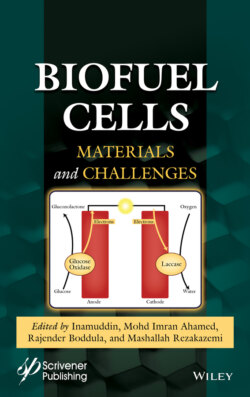Читать книгу Biofuel Cells - Группа авторов - Страница 26
1.6 Bioelectrocatalysis Control 1.6.1 Control of Enzymatic Bioelectrocatalysis
ОглавлениеEnzyme performance is a function of the environmental conditions such as temperature and pH. This latter parameter is of particular importance in enzymatic glucose/oxygen biofuel cells. While glucose oxidase performs better at pH values around 7–8, laccase does so at significantly lower pH (around 4.5–5.5) [7, 50]. This imposes restrictions in single-compartment fuel cells, where both enzymes are exposed to a single solution of a given composition. A compromise must be made to obtain the best performance. Figure 1.12a shows the cyclic voltammograms of a GOx anode and a laccase cathode in solutions of pH 5.5 and 7.4. It can be seen that, despite GOx performing significantly better at pH = 7.4, cathode limitations would be substantial due to the low currents produced by the laccase electrode. A better compromise occurs at pH = 5, where GOx shows a decreased performance (about 50% compared to pH = 7.4) but the increase in laccase current makes for a more balanced system. As a result, a 2.5-fold increase in power is observed when evaluating the complete cell at pH = 5.5 compared to pH = 7.4 (Figure 1.12b).
A way to achieve optimal pH for both enzymes is to use a divided cell. In this case, the cathodic and anodic chambers are separated by a membrane typically made of Nafion [7, 53]. This proton-exchange membrane allows the passage of charge in the form of cations but allows maintaining two different compositions of the catholyte and anolyte solutions. Besides allowing maintaining different acidity levels for each electrode, compartment separation avoids reagent and product crossover between the electrodes. Due to the enzymes’ intrinsic selectivity, the presence of a reactant at the opposite electrode is not as detrimental to the cell voltage as in inorganic fuel cells. The product of one of the reactions, however, might be undesirable for the enzyme at the opposite electrode. Such is the case of hydrogen peroxide, which is produced by GOx, and to which bilirubin oxidase and laccase are sensitive [165].
Figure 1.12 Characterization of the performance of a GOx anode and a Lac cathode through cyclic voltammetry (a) and power curves (b) at two different pH values. Black lines and symbols correspond to pH = 5.5 while grey ones are obtained at pH = 7.4. Republished with permission of the Royal Society of Chemistry, from Chem. Commun., Saravanan Rengaraj et al., 47, 2011, 11861–11863; permission conveyed through Copyright Clearance Center, Inc.
Recently, laminar flow has been explored as another alternative to separate anolyte and catholyte solutions without the need for a membrane. In electrode compartments of reduced dimensions, low Reynolds number regimes exist, preventing solutions from mixing through turbulence. Therefore, the membrane can be obviated. In practice, such systems have taken the form of microfluidic fuel cells in which glucose oxidase, lactate oxidase and laccase and have been employed [107, 148, 166].
The performance of the cell is also determined by the availability of fuel and oxidant at the anode and cathode respectively. Glucose, like many of the fuels, can be employed in solution at high concentrations, therefore ensuring availability at the anode. Oxygen, on the other hand, has a much lower solubility in aqueous solutions, as well as a low diffusion coefficient. Therefore, cathode performance usually limits the overall cell output. A good strategy to increase the availability of oxygen is the incorporation of “air-breathing” cathodes. These electrodes are typically composed of a carbon conductor (in the form of paper) with a hydrophobic membrane. This membrane is generally fabricated with some fluoropolymer and allows the gas exchange between the catholyte and the atmosphere without allowing solution to leak. Such electrodes are therefore exposed to both oxygen dissolved in solution and in gas form from the atmosphere. This strategy has been used in inorganic [144, 167, 168] and biological [42, 148, 169] fuel cell cathodes and has been reported to result in an increase of almost an order of magnitude in current compared to cells without air-breathing cathodes [170].
